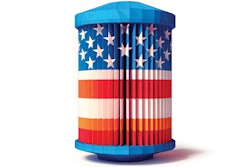
The behavior of colonizing creatures in the natural world is endlessly fascinating. Books and TV programs are devoted to the astonishing feats of intelligent cooperation performed by supposedly dumb ants, for instance, who can organize themselves to build complex structures like shelters, boats and bridges at a moment's notice, often out of their own bodies.
The tiny organisms that grow in recreational water are canny project managers, too, in much the same way. Given a little time and opportunity, they can build a stronghold capable of repelling chlorine and bromine attacks and serving as a base for continued growth and expansion. These common, everyday microbes can organize themselves, take on sacrificial roles for the greater good of the colony and build a pathogen citadel along the wall of a spa or pool.
This base of pathogenic operations is biofilm, a slimy substance often found around the waterline of spas but capable of clinging to any surface in the aquatic environment.
The construction of the biofilm base is a survival strategy for microorganisms. Floating free and alone in spa water, they are easy prey for sanitizers like bromine and chlorine and biguanide. But if allowed to build a biofilm base slathered in protective slime, these microscopic creatures can survive the presence of sanitizers and pursue their agenda of mass replication.
Out in open spa water, these microbes are looking for a solid surface onto which they can attach themselves and where they can immediately set up reproductive operations. Incredibly, once a microbe colony has started a base, they can literally call to other microbes in the spa to come help build fortifications.
This "call" is accomplished through a release of chemicals, which are understood by other floating microbes as an invitation to come over and join the party. And as more microbes arrive and become stuck to the surface, more chemicals are given off, which draw more microbes, and the gathering just grows and grows.
Role Players
At some point, when enough microbes have gathered, and the concentration of chemical invitations gets high enough, then the microbes' metabolism changes and they start to form a three-layer biofilm.
Each layer has a role:
The bottom layer is there to anchor the structure to the surface of the spa. This layer doesn't receive many nutrients from the water (as it's at the bottom), it's just there to keep a good grip on the wall.
The top layer is the outer, exposed surface of the biofilm. Because it is the boundary layer, next to the water, where microbes can get all the nutrients they need, this is where the breeding happens. Of course it's more dangerous here as well, as these organisms are less protected.
The microbes of the middle layer can take on either role. If part of the top layer is killed and sloughs off, these members can take over the breeding activities. Or, if necessary, they can also move down and help anchor the biofilm to the surface.
The most serious problem for the spa professional comes when the layered, living structure is built and the constituent microbes generate a slimy biofilm. This layer of goo insulates the colony from the sanitizer and keeps the bromine or chlorine from doing its job.
Without some kind of direct physical action by the person responsible for spa maintenance, this gelatinous colony will continue to grow.
It's interesting to note that biofilm is typically not made up of just one type of microbe. There are usually lots of different microbes in the biofilm — often bacteria such as pseudomonas and legionella, among other nasty scum-bugs — and despite their genetic and cultural differences, they all work together using this basic plan.
Get Physical With It
Traditional fortresses of almost any age require a tremendous battering to bring down. Fortunately, biofilm redoubts can be reduced more easily. In fact, you can just physically remove biofilm using a brush or sponge and a surface cleaner. The key is understanding the need for regular, diligent cleaning.
For those looking to make the process more convenient, some companies offer a disposable mitt pre-saturated with cleaner that you can simply put on your hand and use to wipe around the spa — but anything you can use to break through that slime layer and get those microbes exposed to cleaning chemicals or the sanitizer in the water will do the job.
This may be part of a weekly maintenance routine, depending on spa usage. If the spa sits unused for a long time, it can go longer between wipedowns.
Regardless of regular maintenance schedules, when the spa is drained, that's an excellent time to go in and do a thorough surface cleaning, making sure to scrub areas that might have been missed in the weekly routine.
Information for this story was provided by Karen Rigsby, business support manager at BioLab in Atlanta. She has a degree in chemistry from Georgia Tech.
Black AlgaeBlack algae is a much more common scourge in plaster pools than spas, but it builds a structure similar to the biofilm found in spas by digging into the pool wall and secreting a sticky protective layer. Actually, black algae is not an algae at all, but a type of bacteria that especially likes the small grooves and rough surfaces common in plaster pools where it can get a firm grip. Diligent brushing is necessary to break through the slimy outer layer of the biofilm and expose cells to the killing effects of chlorine or algaecide. But you don't have to scrub it to death. The trick is patient and consistent daily removal of the outer layer through brushing, and the resultant steady attrition of the outer layers. Don't look for immediate results, just know that brushing destroys the protective layer and allows the biocides added to the pool water (an algaecide specifically made for black algae is recommended) to penetrate and kill black algae cells. — S.W. |








































